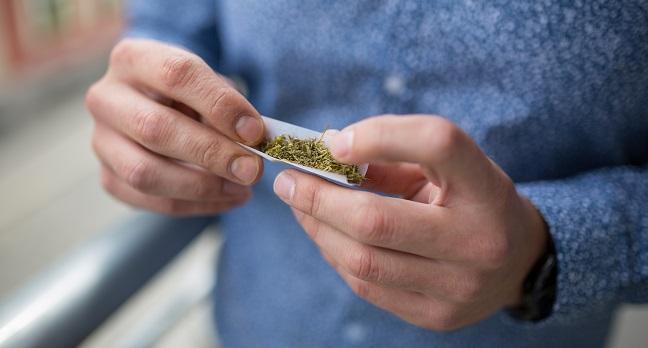No Post-MI Arrhythmia Danger From Using Marijuana, Study Suggests
The fact that cannabis users were 10 years younger, on average, than nonusers when presenting with MI should be a red flag, a researcher says.

BOSTON, MA—More and more people are smoking or ingesting marijuana as legalization for both medical and recreational purposes spreads across the United States, but there are still a lot of unknowns when it comes the effects the drug has on the cardiovascular system. A new study suggests, however, that arrhythmias might not be a major concern in patients admitted with acute MI.
A look at records for patients hospitalized in eight states showed that the proportion with a discharge diagnosis of ventricular tachycardia or cardiac arrest was the same regardless of recent cannabis use (9.7%), and there was still no difference after multivariable adjustment (OR 1.01; P = 0.810).
Of note, trends in other outcomes favored marijuana users, who had a nonsignificantly lower risk of A-fib (4.5% vs 8.7%; adjusted OR 0.85; P = 0.054) and a significantly lower risk of death (4.0% vs 6.0%; adjusted OR 0.79; P = 0.016), Cecelia Johnson-Sasso, BS, a fourth-year medical student, and Christine Tompkins, MD (University of Colorado Denver), reported at the Heart Rhythm Society (HRS) 2018 Scientific Sessions here.
Tompkins told TCTMD, however, that large database studies like this one are hypothesis-generating and can’t be used to advise patients on whether it’s safe to use marijuana. She noted, too, that it wasn’t all good news for cannabis users, who presented an average of 10 years earlier than nonusers.
“I think that people do need to be aware of the 10-year shift in the mean age of MI onset,” Tompkins said, calling the finding a red flag. “But from an arrhythmia standpoint [marijuana use] doesn’t seem to be associated with mortality, ventricular arrhythmias, or cardiac arrest. And there’s perhaps a trend toward decreased A-fib,” she noted.
Sorting out the potential cardiovascular effects of marijuana is taking on greater importance as the drug is legalized in an increasing number of places. Though some case reports have linked cannabis use with arrhythmias, a recent review highlighted the fact that good evidence regarding the effects of the drug on cardiovascular endpoints is lacking. “That is of great concern, mostly because of how quickly states are adopting recreational use,” Tompkins said.
A previous analysis by the CU Denver group showed that among patients admitted for acute MI, marijuana users had lower short-term risks of death and shock. In the current study, Johnson-Sasso, Tompkins, and colleagues turned to the same database to look specifically at arrhythmias.
The cohort was derived using the hospital records of patients admitted with acute MI in eight states: California, Colorado, New Hampshire, New Jersey, New York, Texas, Vermont, and West Virginia. After excluding patients younger than 18 or older than 70 and those who used cocaine or methamphetamine or drank alcohol, the investigators were left with about 1.3 million patients treated between 1994 and 2013. Of those, only 3,854 (0.3%) were listed as marijuana users. The authors note that how use was determined and how patients were consuming the drug is unknown and that the number of users was likely underreported.
On average, cannabis users were younger (47 vs 57 years), more likely to be men, and less likely to have CAD or a variety of coronary risk factors.
After adjusting for those differences, the researchers still found a trend toward less A-fib and a significantly lower risk of death among marijuana users.
Regarding the A-fib finding, Tompkins indicated that it could be explained by the fact that users were generally younger and healthier, differences that might not have been adequately accounted for with statistical adjustments. She pointed out, however, that there is some evidence from animal studies that cannabinoids can exert antiarrhythmic effects.
It remains to be shown whether that’s what’s happening in humans. Epidemiological studies like the one presented here at HRS—which lacked patient-level data and information on angiograms, lab tests, medications, and vital signs—do not provide sufficient granularity, Tompkins said. “I think that these studies are thought-provoking to help guide future studies,” she said.
In addition to continuing basic science investigations, her group has initiated a prospective pilot study to try to gain more insight into the potential effects of marijuana on arrhythmias. Marijuana users who’ve had an MI are wearing ambulatory monitors and are being asked to start recording when they use the drug. That will allow the researchers to determine whether there is a temporal relationship between cannabis use and arrhythmias. The burden of rhythm disturbances will also be compared with that among patients with ischemic heart disease who do not use marijuana and among healthy users of marijuana.
Tompkins said that enrollment in the study is nearly finished and that results could be reported in about a year.
Todd Neale is the Associate News Editor for TCTMD and a Senior Medical Journalist. He got his start in journalism at …
Read Full BioSources
Johnson-Sasso CP, Kao DP, Walker LA, Tompkins C. Arrhythmic effects of marijuana following acute myocardial infarction. Presented at: HRS 2018. May 10, 2018. Boston, MA.
Disclosures
- The study was funded by the Colorado Clinical and Translational Sciences Institute and the Colorado Department of Public Health and Environment.
- Johnson-Sasso and Tompkins report no relevant conflicts of interest.


Comments